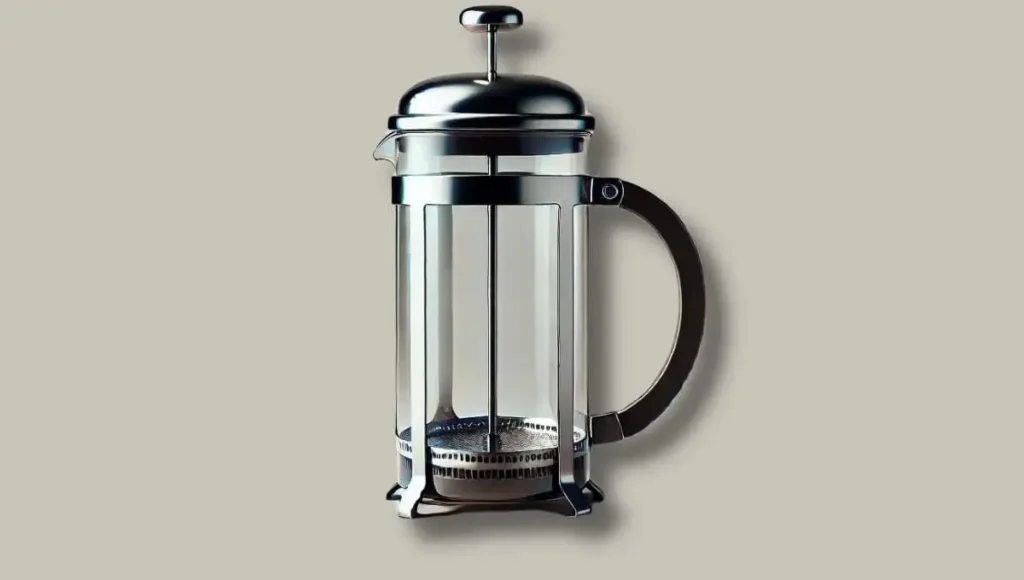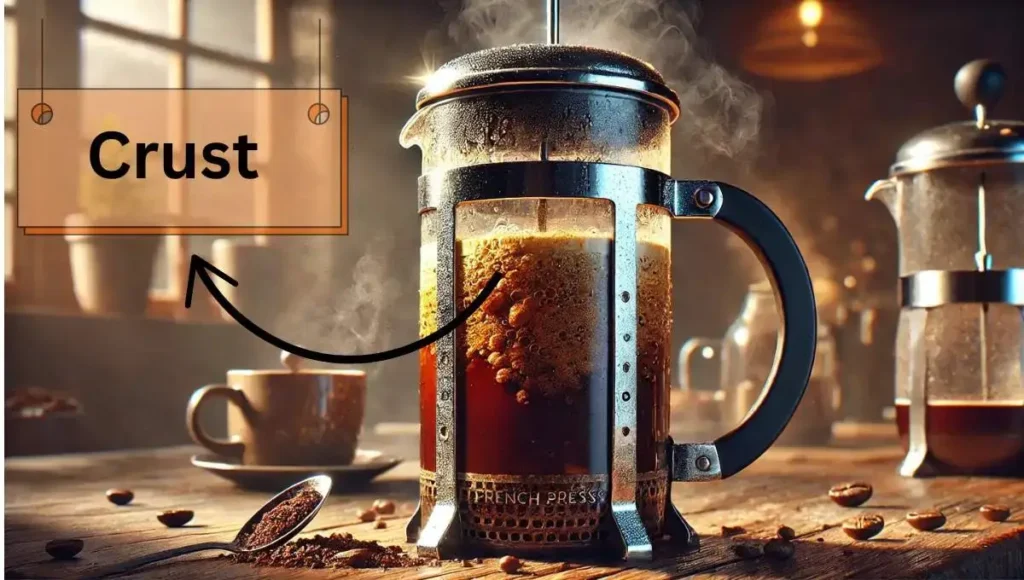When making French press coffee, the standard ratio is usually a 1:15 ratio—meaning for every 1 part of coffee, you use 15 parts of water. To break it down further, this translates to using 15 grams of water for every gram of coffee grounds. However, this can be adjusted depending on your preferred strength.
If you like a stronger cup, you can experiment with a slightly lower ratio, such as 1:12. Just keep in mind, no matter which ratio you choose, it’s crucial to use a coarse grind to get the best results.
The ratio you use ultimately shapes the flavor, so it’s important to get it right. If you’re new to the process, start with the standard ratio of 1:15 and tweak it from there. A stronger brew calls for a bit less water, while a milder cup may need a little extra.
Also, always remember that the grind matters just as much as the ratio. A coarse grind allows the coffee to extract more smoothly, without over-extracting the bitter flavors.
So, whether you’re aiming for a bold or balanced brew, your ratio and grind are the foundation for great French press coffee. Key points to keep in mind include important considerations like your coffee-to-water ratio, and the strength you desire, all of which play into the overall experience.
What is a French Press?
A French Press is a simple yet effective way to make coffee, consisting of a cylindrical pot with a plunger and a built-in filter screen. This design helps you press hot water through ground coffee, creating a rich and earthy taste that many coffee lovers appreciate.

The beauty of using a French Press lies in its ability to deliver a bold, full-bodied flavor in every daily cup of coffee. Whether you’re a seasoned coffee enthusiast or new to the French Press, the process is straightforward and the result is always satisfying, making it a popular choice for many.
French Press Ratio Facts!
What is the ratio for french press coffee?
The most common coffee-to-water ratio for French press brewing is 1:15. This means you should use one part coffee to fifteen parts water by weight. To illustrate, a 1:15 ratio means that for 30 grams of coffee, you would add 450 grams of water (derived from 30 grams of coffee x 15 = 450 grams of water).
While 1:15 is the widely recommended starting point for a balanced brew, this ratio can be adjusted to personal preference:
- For a stronger brew: Consider a ratio of 1:12 to 1:14.
- For a lighter brew: A ratio closer to 1:16 to 1:18 is often preferred.
Beyond the ratio, optimizing your French press technique involves:
- Consistency: For the most accurate results, using a kitchen scale to weigh both your coffee and water is highly recommended over volumetric measurements like tablespoons.
- Grind Size: Use a coarse grind to minimize sediment and ensure proper extraction.
- Water Temperature: Aim for water between 195–205°F (90–96°C).
- Steep Time: The recommended brewing time is typically 4 minutes.
Benefits and Drawbacks of French Press Coffee
Pros of French Press Coffee
- It’s one of the simplest methods to make coffee.
- It doesn’t take much time to brew a fresh cup of coffee.
- You can brew a large amount of coffee in one go.
- Saves time, compared to the pour over method.
Cons of French Press Coffee
- Regular pre-ground coffee or espresso ground coffee isn’t suitable for French press brewing.
- For the best results, coffee beans should be coarsely ground when using a French press.
- The coffee sits directly on the grounds during brewing, which can sometimes lead to bitterness and an oily texture.
- Cleaning the French press can take a bit more time compared to other brewing methods, as you need to thoroughly clean the plunger and carafe after each use.
How to Make French Press Coffee: Step-by-Step Explanation
When brewing with a French press, it’s essential to choose the right type of ground coffee beans. Unlike regular pre-ground coffee, which has a fine, sandy texture that’s ideal for drip machines, you’ll need coarsely ground coffee for the best results with a French press.
The beans should resemble breadcrumbs, which helps with steeping and enhances the flavors. If you’ve ever used a grinder at a grocery store, you’ll know that setting the grinder to the furthermost left setting is essential to get the right grind.
The larger surface area of coarsely ground coffee allows it to steep more effectively, resulting in a better-tasting cup. This method involves steeping the coffee grounds in water for a few minutes, which helps to bring out the flavors more effectively.
This is one of the reasons why it’s also easier to push the coffee grounds with a plunge.
- Does NOS Energy Drink Have Caffeine? Expert Guide (2025)
- Does Bubbl’r Sparkling Water Have Caffeine? Full Breakdown In 2025
- Does Elderberry Energy Drink Contain Caffeine? Complete 2025 Review
Instructions
Start by grinding the coffee beans
To make the perfect French press coffee, begin by grinding 1/2 cup of coffee beans on the coarsest setting of your coffee grinder. The coffee grounds should be rough, coarse, and evenly sized, similar to breadcrumbs.
Next, pour the coffee grounds into the French press
Once done, pour the grounds into a 34-ounce or larger French press. Then, heat 4 cups of water either on the stovetop or using an electric kettle until the water is boiling. Once it boils, pour half of the hot water into the press, filling it up halfway, and let it sit for about 1 minute, uncovered.
Stir the top layer of coffee grounds to break it up
Then, using a wooden spoon or chopstick, gently stir the top layer of coffee grounds to break it apart. Pour in the rest of the hot water, making sure to mix the grounds thoroughly with the water while stirring.
Steep and press the coffee
Place the lid/plunger on the press, but don’t press it down yet. Let the coffee steep for 4 minutes. Once that’s done, slowly press the plunger all the way down to separate the grounds from the coffee, and then serve right away.
Clean the French press after each use
Make sure to wash the French press after each use with mild detergent and dry thoroughly.
Perfect Coffee-to-Water Ratio for French Press
When brewing coffee with a French press, the ratio of coffee to water is key to getting the perfect cup. The most common size for a French press is 32 ounces, which typically yields about four servings. Depending on the size of the French press, you might need to adjust the ratio accordingly.
| Number of Servings | Water (oz) | Coffee Beans (cups) | Coffee Beans (tablespoons) |
| 1 | 8 | 1/8 | 2 |
| 2 | 16 | 1/4 | 4 |
| 4 | 32 | 1/2 | 8 |
| 8 | 64 | 1 | 16 |
Choosing the Best Coffee for French Press
Best coffee bean types and roast levels
When using a French Press, the coffee brewing process pairs wonderfully with medium to dark roasts. If you enjoy adding milk and sugar to your coffee, a dark roast will work perfectly. The rich, earthy, and chocolatey flavors of the coffee really shine through, especially when you enhance them with a touch of milk. This balance creates a full-bodied and satisfying cup that complements the French press brewing method.
Recommended grind size
For the best results when making French press coffee, it’s important to choose a medium grind that has good uniformity and consistency. Grinds that are too coarse may clog the filter, while fine grinds can pass through and make the coffee muddy, ruining the final taste. Aim for a grind that balances between being rough but not overly chunky, ensuring the flavors come through clearly without unwanted residue in your cup.
What is a Crust in French Press Coffee?

When you pour hot water over coarsely ground coffee beans in a French press, you’ll notice a layer of coffee grounds floating at the top. This is the bloom, an important stage where the hot water extracts all the flavors from the ground coffee beans.
As the brewing continues, a thick crust of grounds will form on the surface. This crust is crucial to the French press method, and it’s important to break it apart after the steeping process. You can easily do this with a spoon or chopsticks, allowing the full potential of the flavors to be released into your coffee.
Nutritional Information of French Press Coffee
Nutritional Information of French Press Coffee (Black, 8 oz / 240 mL):
For French press coffee, when you consume it black without any additives, it’s incredibly low in calories and macronutrients. The nutritional profile might change a little depending on the brewing time, the type of coffee bean, and the method of preparation.
Here’s a general breakdown of what to expect from your coffee when brewed using a French press.
Basic Nutritional Profile (per 8 oz cup):
| Attribute | Value |
| Calories | ~2–5 kcal (virtually negligible, from natural coffee oils and compounds) |
| Protein | 0 g |
| Fat | 0.1–0.5 g (trace amounts from coffee bean oils retained due to no paper filtering) |
| Carbohydrates | 0 g (unless sugars/milk are added) |
| Fiber | 0 g |
| Caffeine | ~80–135 mg per 8 oz (varies by bean type, grind size, and steeping time) |
| Antioxidants | Rich in polyphenols (e.g., chlorogenic acids) linked to anti-inflammatory benefits |
| Minerals | Trace amounts of potassium, magnesium, and manganese |
| Vitamins | Small amounts of B3 (niacin), formed during roasting |
Factors Affecting Nutritional Content:

- Brewing Time: When it comes to brewing time for French press coffee, longer steeping times, typically between 4–5 minutes, allow for more complete extraction of caffeine and natural oils from the coffee grounds.
- Coffee-to-Water Ratio: The coffee-to-water ratio plays a crucial role in this process: the more grounds you use, the stronger the caffeine and flavor in your brew.
- Additives: However, if you prefer to add additives like milk, cream, sugar, or syrups, keep in mind that these will significantly increase the calories, carbs, and fat content of your coffee.
Health Considerations:
Unfiltered Coffee and Its Effects
One important aspect of French press coffee is that it is unfiltered, meaning it lacks a paper filter. As a result, it retains natural oils such as cafestol and kahweol, which can slightly raise LDL cholesterol when consumed excessively (more than 5+ cups/day).
Acidity and Stomach Sensitivity
Another factor to consider is the acidity of French press coffee, which may irritate sensitive stomachs more than filtered methods. If you have a delicate digestive system, this could be something to keep in mind.
Hydration and Caffeine Effects
Although coffee is a mild diuretic due to the caffeine content, it still contributes to your daily fluid intake. So, while it may increase bathroom trips, it doesn’t dehydrate you as much as some might think.
Conclusion
When brewing French press coffee, getting the right coffee-to-water ratio is crucial for the perfect cup. A general guideline is to use 1:12 for a balanced brew, but feel free to adjust depending on your preferences. For example, if you’re brewing 1 serving (about 8 oz), use 2 tablespoons of coffee grounds, and scale up from there for more servings.
The grind size matters too—choose a medium grind for the best results, as very coarse or very fine grounds can cause issues with the filter or muddy the coffee.
Additionally, take note of factors like steeping time and water temperature, which also affect the outcome of your coffee. By experimenting with these ratios and techniques, you can tailor the French press to your taste for an enjoyable coffee experience every time.
FAQs
How much coffee do I put in a French press?
For making 2 or 3 good cups of coffee, we suggest using 40 grams (or 9-10 tbsp) of ground coffee. This amount ensures that you get the perfect strength and flavor for a satisfying brew in your French press. Whether you’re brewing just 2 cups or scaling up to 3, this amount of coffee will give you that ideal rich and flavorful result.
What is the golden ratio for French press coffee?
The typical French Press brewing ratio is 1:15, meaning for each gram of coffee grounds, you should use 15 grams of water. This ratio is easy to remember and simplifies the brewing process. While the golden ratio in mathematics holds a more complex value of 1.61803398875, when it comes to brewing coffee, the 1:15 ratio ensures a perfect balance of strength and flavor for your cup.
What ratio for 500 ml French press?
For the French Press, a popular brewing ratio is 1:14, meaning for every 1 gram of coffee, you should use 14 ml of water. If you’re brewing larger amounts, this ratio scales up accordingly, so for 35 grams of coffee, you’ll need 500 ml of water. This ratio strikes a good balance, offering a flavorful brew without being too weak or too strong, making it a great guideline for perfect French Press coffee.
How many scoops of coffee per cup?
For a standard coffee cup (typically 12 ounces), the ideal amount of coffee grounds is two coffee scoops or 4 tablespoons. This ratio will yield a robust and flavorful cup of coffee, perfect for those who enjoy a strong brew. Whether you’re brewing in a French Press or other methods, this measurement will ensure you get the right strength and taste from your coffee.




